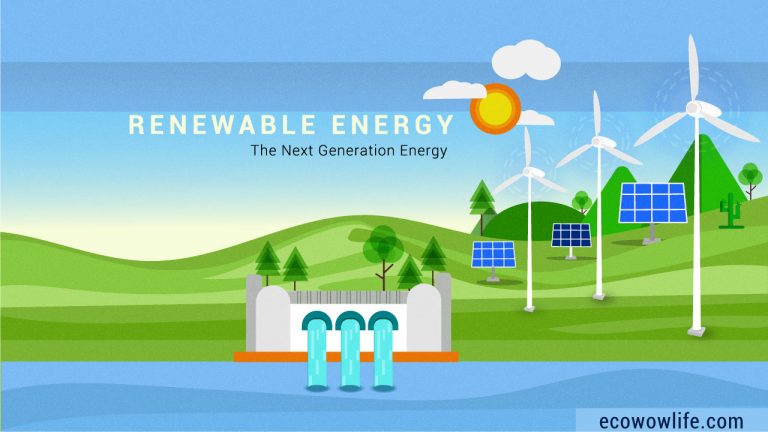
In this write-up, let’s have a glimpse of an idea about clean renewable energy. This article is the ultimate overview of alternative green energy such as solar, wind, hydro, biomass, and more.
Before kickoff, let’s encounter some harsh truth of the primary sources of energy –
- Oil deposits could replenish in just over 53 years.
- Gas might leave within 52 years left
- Coal deposits could be finished in 150 years.
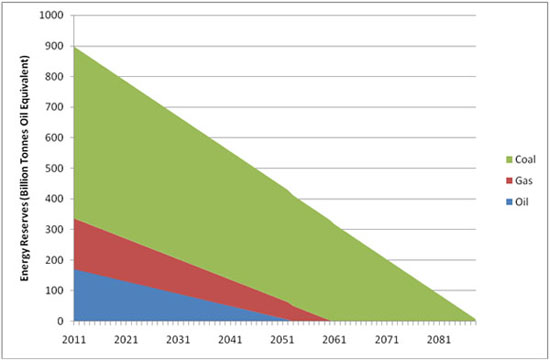
image Sources:ecotricity.co.uk
In recent study shows, In the United States, emissions of carbon dioxide are projected to increase by 2.5 percent in 2018 after a decade of declines for excessive uses of non-renewable energy such as oil, gas, and coil.
It’s very alarming right!!
Do you ever imagine if the primary sources of energy used up thoroughly, then what will happen?
Can we replenish them again in a short duration? The answer is simply “NO”.
As non-renewable available in limited quantity, it cannot be renewed or replenished in a short duration.
Non-renewable energy is not environmental-friendly at all; they produce an enormous amount of carbon. Those energy sources are directly involved in causing global warming.
Right now, the Earth is experiencing massive climate change due to increased Carbon dioxide, methane gas, nitrous oxide, and other gases.
Here arise two questions naturally –
How much energy will leave for the next generation? And
How to reduce carbon emission from our daily use?
Let’s find out how clean renewable energy will play a significant role to conserve energy for the next generation? And why it is eco-friendly clean green energy.
Why It’s high time to switch renewable energy sources like solar, wind, hydropower, biomass, and more?
Let’s crack this out into this reading.
What is renewable energy? The simple definition of clean renewable energy :

Renewable energy is naturally replenishing from sources but flow-limited. Renewable resources are almost inexhaustible in duration but limited in the amount of energy that is available per unit of time.
It’s also called green energy because the sources of renewable energy, produce a very little amount of carbon once operating.
This alternative energy sources are the modern energy roots would be the pioneer to green future civilization. Clear decision-making, a supportive regulatory environment, a strong partnership between the public & private sector is crucial. Also, technological advancement and public awareness will create pathways to implement a sustainable future with renewable energies.
If solar energy is, for say, earth’s God, other energies are its goddesses without which we can’t even exist. Earth is driving through a myriad of energies, which we perceive as our significant resources. Based on the replenishing capacity all the energy resources are divided into two –
- Renewable &
- Non-renewable energy.
History or evaluation of Renewable energy :
The fire was civilization’s first excellent energy invention, and wood was the primary fuel for a long time.
Since then, different energy sources and technologies evolved. Wood was the source of nearly all the nation’s energy until the mid-1800s.
Wood needed for cooking, lighting, and heating. Fossil fuels (i.e., coal, petroleum, and natural gas) become the primary sources, from the late 1800s until today.
Until the 1990s Hydropower and solid biomass were the most used renewable energy. (U.S. Energy Information Administration, 2019).
As we see, the historical production of renewable energy is dominated by traditional biomass. Those included the burning of wood, forestry materials, and agricultural waste biomass.
Although hydro-power implemented at smaller scales throughout the country for thousands of years. But they did not feature at large production scales.
Hydro-power started to flourish with pumped storage development after the 1920s.
Currently, traditional bio-fuels continue as the largest source of renewable energy. Biofuel accounting for 60-70% of the total energy.
Traditional biomass remains the dominant fuel source. Biomass used for cooking & heating across many low-income households.
The World Bank reports that- Only 7% of the world’s low-income households have access to clean fuels and technologies for cooking. (Ritchie & Roser, 2019)
The average share of clean fuel in Sub-Saharan Africa was 13%. And approximately one-third of clean fuel share existing in South Asia., Hydropower remains dominant of the remaining renewable technologies — hydropower accounting for roughly one-quarter of renewable consumption. (Ritchie & Roser, 2019)
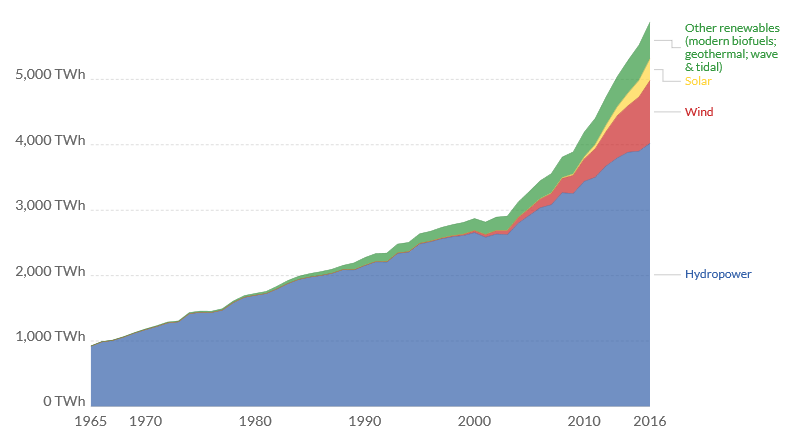
Image source: Modern Global Renewable Energy Consumption. Total renewable energy consumption, measured in terawatt-hours (TWh) per year. This data includes all renewable energy sources with the exclusion of traditional biomass. (Our World in Data)
Now let’s find out what is the major renewable sources of energy
The major renewable energy sources are:

- Solar energy
- Wind, like large wind turbines, generates electricity from the power of the wind.
- Hydro power: Water or hydro like tidal power
- Geothermal
- Biomass, Types include:Wood and wood waste,Municipal solid waste,Landfill gas and bio-gas,Ethanol,Bio-diesel
Here we just list down the major sources of renewable energy. Later on, we discuss every component about sources of renewable energy.
Before that, let’s dive into non-renewable energy.
Here we overview every component of non-renewable energy. It will start from definition and cover all the major resources of non-renewable energy along with data and lots of cool stuff.
What is non-renewable energy?
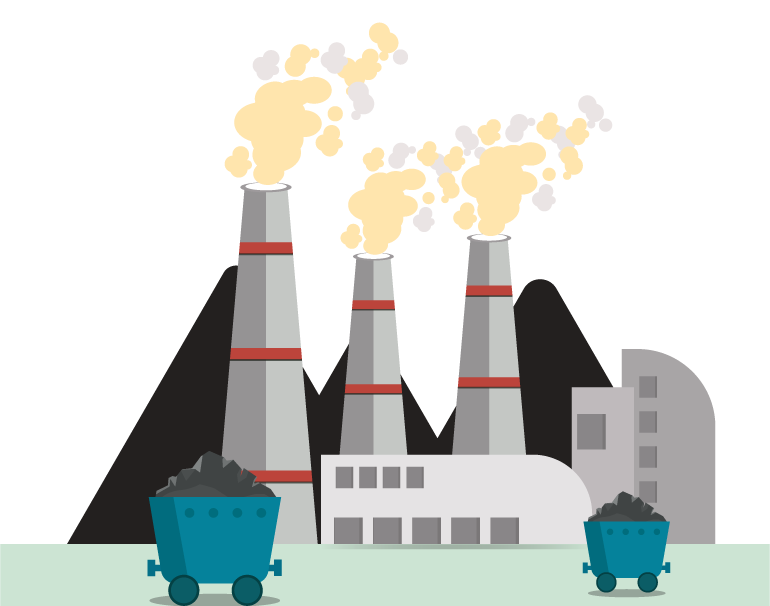
Another energy form is Non-renewable one, which available in limited quantity and cannot be renewed or replenished in a short duration. Therefore they are also known as exhaustible sources.
The four major nonrenewable energy sources are:
- Crude oil (petroleum)
- Natural gas
- Coal
- Uranium (nuclear energy)
Renewable energy vs non-renewable energy : Difference between renewable and nonrenewable energy
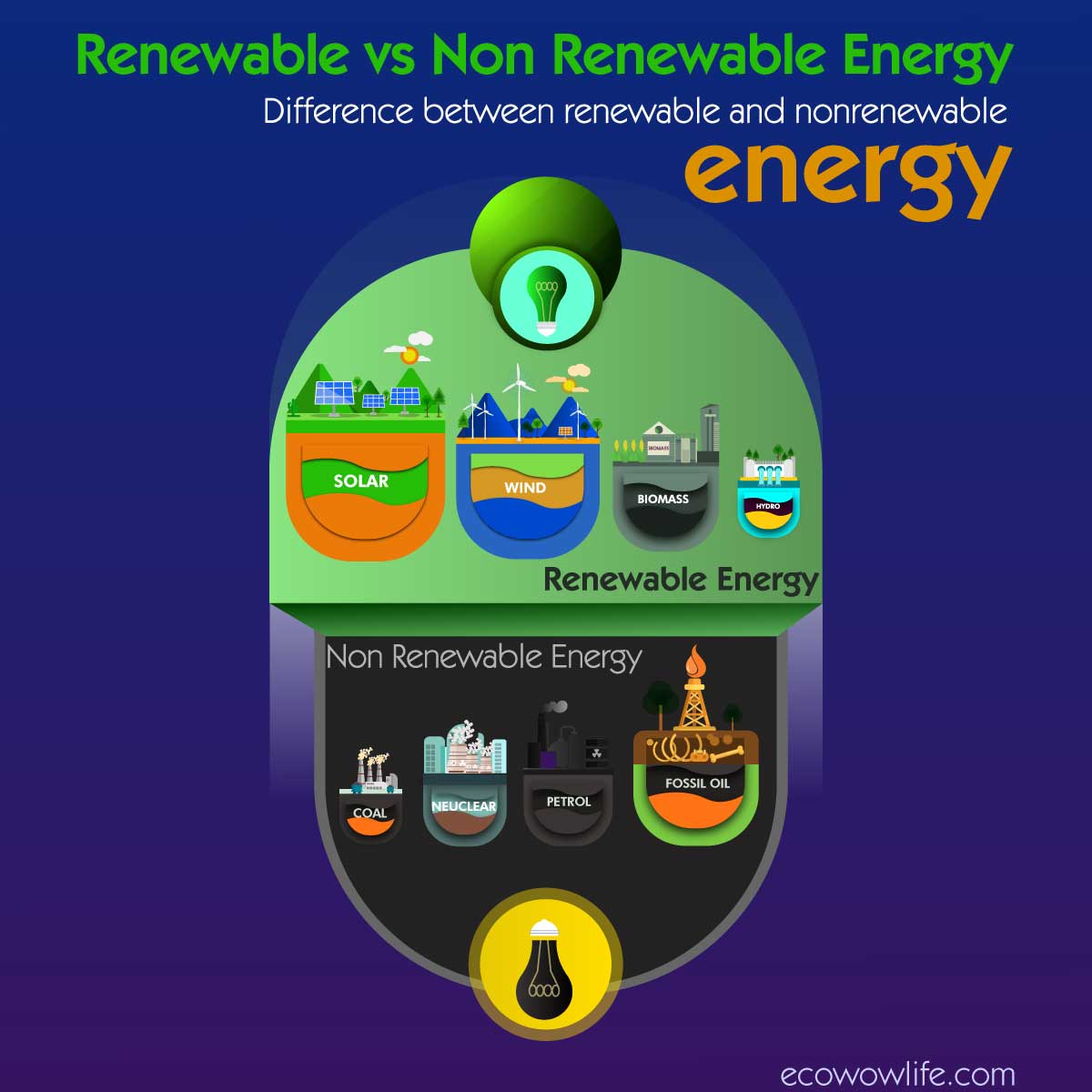
| Renewable Energy | Nonrenewable Energy | |
| Definition | Natural energy resources that can renew itself sufficiently. It’s a clean and sustainable source. | Energy resources that do not renew itself sufficiently in meaningful human time-frames. It’s not meant to be sustainable economic extraction. |
| Limit | Unlimited | Limited |
| Effect on Environment | They are environmental friendly mostly | Mostly harmful to the environment |
| Restrictions | Convenient to use | There are restrictions in using these |
| Cost | Freely available in nature, but usually, installation & implementation are costly | Expensive; but implementation is readily feasible & cheaper than that of renewable one. |
Types of nonrenewable energy : Example of non renewable energy
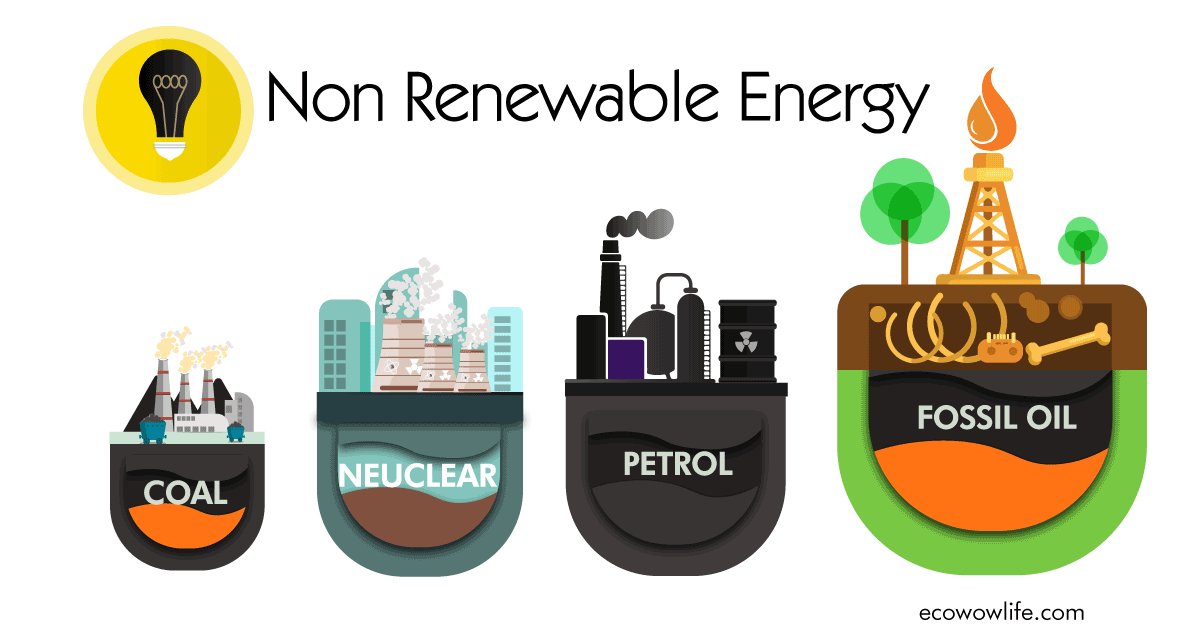
The sources of Non-renewable energy will run out easily. Those sources will not be replenished for thousands or even millions of years. Nonrenewable resources are only fall under two main categories:
- Fossil fuels
- Uranium (radioactive minerals)
The sources of non-renewable energy are mostly fossil fuels. Fossil fuels were created as the remains of marine creatures. They decayed millions of years ago under vast amounts of pressure and heat. Coal, above, is a type of rock that is a fossil fuel. Most fossil fuels include petroleum products such as crude oil, coal, and natural gas. They are burned to create energy and electricity.
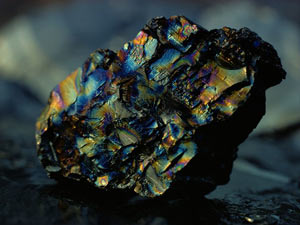
Sources: Non renewable Peacock coal (by James P. Blair, National Geography)
Nonrenewable energy sources usually come out of the ground as liquids, gases, and solids. Crude oil are been used to make liquid petroleum products such as fuel, gasoline, heating oil, and diesel. Propane and other hydrocarbon gas liquids are found in natural gas and crude oil.

Image: Petroleum, also called crude oil or just “oil” (by Rebecca Hale, National Geography)
Uranium ore, a solid, is mined and that is converted to a fuel used at nuclear power plants. Uranium is not basically a fossil fuel, but it is categorized as a nonrenewable fuel.
What is the meaning of clean energy and unclean energy? Is renewable energy clean? All sources of renewable energy are clean and sustainable?
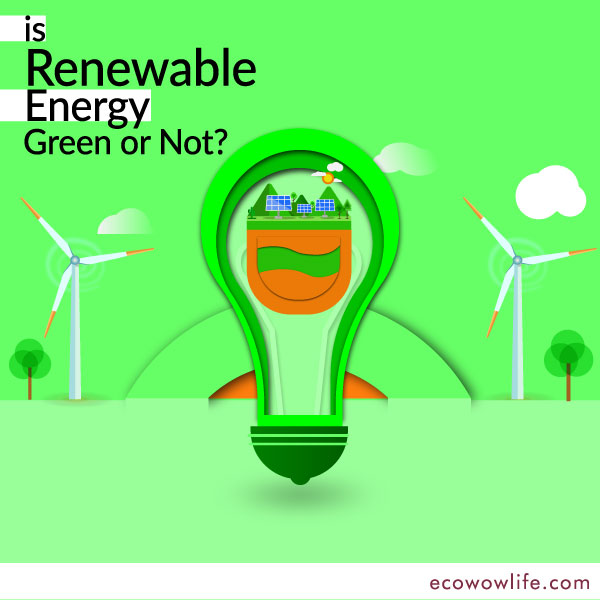
Clean energy or green energy is produced through means that do not emit greenhouse gas to the atmosphere. Its primary sources are the renewables like solar energy, hydro energy, and wind energy. We have already found ways to harness the electricity from sun, water, wind, and waves, amongst other renewable sources.
These sources produce only minimal amounts of greenhouse gas once operating if any at all – now that’s called clean! Those are also renewable, that means they can be used over and over again.
The bottom line is very clear, Overall renewable energy creates a lively vibe in the environment. They do not create too much carbon footprint and other toxic pollutants.
Overall renewable energy creates a lively vibe in the environment. They do not create too much carbon footprint and other toxic pollutants. So it’s also called eco-friendly energy.
Global warming is increasing in the average Earth’s temperature caused by GHG emissions. All sources of renewable energy considered sustainable, green power, and eco-friendly. Because they help to negate the effects of global warming, these are also called alternative energy sources.
The dirty or unclean energy are those that produce GHG to lead the cause of climate change. As the burning of fossil fuel is an example of unclean, dirty energy. Our electricity mostly comes from power stations that use fossil fuels like coal and oil.
The power stations burn fossil fuels to make our electricity. In this process, a number greenhouse gas emitted, including carbon dioxide and methane. That’s why they are called dirty or unclean sources of energy — these evil gases causing the Earth’s atmosphere to warm exponentially.
The GHGs are deliberately creating the global issue of climate change. With time it will cause more extreme weather and the spread of diseases.
Climate change will also threaten all living habitats. Coal, gas, and oil are non-renewable sources of energy because once they have been used up, that’s it! We can only use what is available.
Now it’s time to discuss the impact of clean renewable energy.
Impact of Renewable energy : The major impact factor of renewable energy :
Now a day’s impact of renewable energy hugely affected several sectors such as environment, economics, society, job, education, health along with energy consumption perspective
Let’s list down the impact of the Renewable energy:
- Impact on the Environment.
- Impact on the socio-economic structure
- Impact on health sector will improve public health:
- Impact on education sector
- Impact on energy consumption or conservation
- Impact on job sector
- Impact on parenting
Impact of renewable energy on the environment : Renewable energy leads to:
- Very minor or no carbon imprint of producing GHG
- Less production of toxic pollutants
- No dependency on fossil fuel combustion
- No adverse effect of environment & its biodiversity
- Cause to temperature enhance of global warming
Impact of renewable energy on the socio-economic structure
In terms of modern economies and the central need for modern life, energy is the foundation. An important development goal is accessing to energy.It is a prerequisite for economic growth.It is a prerequisite for economic growth.
- It improves living conditions and alleviating poverty.
- Providing it to developing countries is a daunting task. Such obstacles include high energy costs, unaffordable energy grid infrastructure, and disperse population.
- Renewable technologies offer affordable and sustainable energy to millions of people.
- Renewable technologies, in particular, offer diverse and economically attractive options for rural electrification.
Impact of renewable energy on health sector will improve public health:
- Better health is associated with intake of energy.
- Infant mortality and life expectancy improve, those are under population metrics.
- Energy availability is also related with health issues at the household level. It’s also impact on “energy security” and “energy poverty”.
- Energy security refers to a family’s probability at the household level of heating the home during cold weather, having enough energy to cook food, and cool the house during warm weather. It is a matter of availability, affordability, and capacity.
- Energy poverty (or fuel poverty) refers to financial hardship in affording energy for these primary uses. It’s related to economic poverty, including poor health and adverse social outcomes.
Impact of renewable energy on education sector
-With less GHG, the students’ overall absenteeism due to health issues decreases.
– Many schools are being implemented
STEM program: It’s a curriculum based on the idea of educating students in science, technology, engineering, and mathematics. It’s an interdisciplinary and applied approach.
DREAMS program: It entails design, research, engineering, art, math science. They form a student research team that works actively with experts. They become child scientists who get recognized with the applied knowledge. With these facilities, students become an active citizen who knows about:
-
- Energy, conservation and waste-water management
- Goal net-zero operation across the board
- Curriculum forming knowledge & skill to confront local & global issues.
Impact of renewable power on energy consumption
Energy conservation refers to reducing energy using less of an energy service. Energy conservation differs from efficient energy use. Its conservation refers to using less energy for a continuous function.
Impact of renewable energy on job sector
- Total energy use is related to economic output and population growth. But there is much difference in the efficiency of energy use across societies.
- Economic productivity drive by the amount of energy used, as well as the quality of energy. More efficient and flexible energy sources are associated with higher productivity.
- Fuel/energy ladder is the idea that the use of cleaner fuels marks increasing development and wealth.
- Energy availability is not the only trigger of development. Education and women’s rights, labor markets, , physical infrastructure, financial institutions, geography, and other factors also play central roles.
Impact on parenting : Renewable energy practices draw on positive impact on parenthood
Renewable energy practices bring a positive impact on parenting, it’s open the door to teach your children about the necessity of the conserve energy and the environmental issue. Adopting renewable energy practices is the sheer statement that you are enough conscious about environmental protection and energy consumption thus your kids will grow up with environmentally friendly practices along with you. The parents can adopt some energy-saving tips-
- Adjust the day-to-day behaviors
- Replace the light bulbs
- Use smart power strips
- Install a programmable or smart thermostat
- Purchase energy-efficient appliances
- Reduce the water heating expenses
- Install energy-efficient windows
- Upgrade HVAC system
Advantages & disadvantages of renewable energy

Unlike non-renewable energy resources that we cannot store what we collect with renewables over long periods.
The United States presently has a stockpile of coal that could last up to 400 years at current consumption levels (Gaille, 2018). With wind or solar energy, a battery is required to store the collected energy.
That can provide sufficent energy for about 24 hours of use if enough power has been stored. There are number of advantages and disadvantages of renewable energy, which must be considered.
By definition Fossil fuels are a finite resource. Exploring options to replace them, they could possibly become in short supply, allows us to continue to progress our society and our lifestyle under modern definitions.
Advantages of Renewable Energy
- Renewable power is a safe form of energy:
Renewable energy’s collection and use process are typically more reliable than non-renewable energy methods. If you use wind or solar energy then you don’t have to worry about the risk of a nuclear reaction or particulate pollution from a coal-fired plant.
- It is an abundant form of energy:
For Example, one day of sunlight equals one year of energy. We do not have the resources at the moment to collect & store that energy. Wind gives us with constant energy resources, as well.
- It is a clean form of energy to use:
Although renewable energy is constructed on an infrastructure that uses fossil fuels, the emissions cost-savings of renewable occurs quite rapidly.
Depending upon the type of renewable energy that are being used, positive gains can be expected between 5-25 years with most options.
That means a five years investment can begin successful how we collect energy for a lifetime.
- It can be collected in multiple locations simultaneously:
We use versatile forms of renewable energy today, even without realizing it. One of the most common types of renewable energy in the United States comes from hydropower. Dams are built on rivers, also on the moving water runs turbines that are able to generate electricity.
- It is offered in multiple formats:
Energy diversity is possible through renewable energy. New technologies, such as road-based solar panels allow for energy collection within current infrastructure layouts. From small stations to extensive facilities like Hoover Dam, the levels of diversity are much more significant for renewables than non-renewables. That means enormous potential for power generation now and into the future.
- It can provide nations with energy independence:
The average country in our world mostly depends on traditional non-renewable energy for its power resources. Transitioning to renewable energy can reduce the dependence on fuel imports or international aid to meet power demands.
- It is a stable form of energy:
The electricity it creates can be used with the current infrastructure, as long as there is a link to the renewable facility that easily accesses the leading network. That makes it appropriate for virtually any power need, from computers to automobiles to general heating and cooling.
- It is an economic Strength :
In the United States, renewable industry is responsible for about 800,000 jobs. The wind energy industry added 25,000 new manufacturing and installation jobs in 2016. Solar added another 73,000 jobs (Gaille, 2018).
- It is a clean technology:
The cause why non-renewable energies tend to be cheaper today is that it is a commodity. Oil, natural gas, petroleum, gasoline– these are products that are bought and sold to be consumed. Renewables are different.
They are a technology, not a fuel. You don’t burn a wind turbine; you have to install it. At present, renewable energy technology, becomes cheaper as production and installation methods are refined.
- It is easy to maintain renewable energy collectors:
Once a renewable energy production has been installed, the charges of maintaining that technology are comparatively low. Many clarifications can have a no-maintenance lifestyle for years at a time.
- Clean renewable energy able to improve public health:
There are potential health benefits that society may see if it changes to renewable energy use. A research by the U.S. Environmental Protection Agency discovered that almost $1 trillion is spent each year on situations that could be linked to the consumption of fossil fuels.
That includes heart disease, asthma, certain cancers, neurological disorders, and several other health concerns.
Reducing our dependence on fossil fuels not only helps us live healthier, but it puts more money back into us from related expenses we don’t even think about.
- It can be used to recycle our own waste products:
This is one significant benefit that biomass energy inclines to have more than other forms of renewable. Biomass consumes used organic goods to generate energy. It means it can produce power from used vegetable oil, corn and soybean byproducts, or even algae.
It reduces the amount of waste at the same time that goes into landfills while also reducing overall carbon emmision that goes into the atmosphere.
- Renewable energy can be profitable in long run:
How much money could solar panels or other forms of renewable energy save the average homeowner?
Over 20 years, the savings on electricity costs alone could be more than $30,000 for some homeowners.
In New York, California, and Massachusetts, the predictable 20-year savings is more than $25,000 with solar panels. Based on the average cost of setting up, that can be as much $17,000 more you’ve earned in that same period. (Gaille, 2018)
List of the Disadvantages of Renewable Energy
It is not as cost-effective:
It has Higher upfront cost; While you can save money by renewable energy, the technologies are typically little bit expensive upfront than traditional electricity generators.
It isn’t always a viable option commercially:
Most renewable energy options must be collected at a specific geographical source. Imagine trying to receive high levels of solar energy while living in Seattle or using tidal energy while living in Nebraska. For renewable energy to be adequate, it must have a distribution network created to transfer the energy to where it is needed.
It is though generates pollution:
Renewable energy souurces may be a better option for reducing emission than fossil fuels, but that doesn’t mean it is free from pollution. Many forms of renewable energy emit particulates into the air. They may emit carbon dioxide, or worse – methane.
It may not be a stable energy resource:
The environment evolves, shifting where renewable resources become available. Some places, such as offshore wind or tidal energy, are generally quite reliable. Solar energy, however, can be challenging to predict. Geothermal energy may change over time. Billions of dollars can be expended to advance renewable energy resources only to have that money go to waste if that resource discontinues producing as expected.
It can often be influenced by politics:
Although renewable energy is common accepted as the future of energy manufacture globally, politics can be a undesirable influence on its development. If renewables are not given a political importance, then the industry tends to falter, and innovation is reduced in favor of non-renewable options.
It is an energy resource that is tough to access for many people:
In the United States, over 30 years, the government-funded more than $100 billion in energy subsidies.
Over half of those subsidies were focused toward nuclear power — just 26% of those subsidies were funneled toward renewable energy technologies and energy efficiency priorities.
Even with solar subsidies of up to 88 cents per kilowatt-hour being provided, accessing that energy is not cost-effective for many low-income families. That means the importance stays on non-renewables, which further prevents innovation within this sector. (Gaille, 2018)
It can take a lot of area to install:
Using current solar energy generation technologies, it takes over 40 hectares of panels to produce about 20 megawatts of energy. In comparison, a nuclear power plant in an average size generates about 1,000 megawatts of energy on 259 hectares. (Gaille, 2018)
It isn’t an endless energy source:
Then, there is the issue with consistency. Nuclear and coal energy can be used at any time. Many renewables can only be collected during definite periods of the day time. Solar energy, for example, isn’t collected at night time.
Wind energy cannot be collected unless there is wind. Even then, wind energy is often ineffective as the turbines have a minimum and maximum wind speed during which they operate.
It has expensive storage costs:
This is one of the pricing factors that are often excluded from the conversation on renewable energy is the storage cost. You must need to store the energy collected, or you will lose it, which means having a battery installed.
The general storage cost for the energy is about 9 cents per kilowatt-hour, but the charge of the battery is upfront.
That means $10,000 to $25,000 upon installation just for the battery. Some types of batteries cannot be useable very quickly, especially if their full capacity is being used on a regular basis.
It has huge capital costs:
If there is a new energy resource needs to be developed for a community right now, the capital cost of the resource will be a primary consideration. Right now, the capital costs of non-renewable energy resources are lower than the capital costs of renewable energy.
This may change over time, but is a main reason why renewable energies are not favored in some parts of the world today.
Why are many countries starting to practice Renewable energy uses? What’re the reasons behind?
The debate over the energy model can continuously be heard on the street. The leading cause of many countries trying to switch to the alternative source of renewable energy are:
- Advantages and disadvantages of oil, gas, and coal
- The nuclear controversy
- The viability of renewables
Among the torrents of arguments, here are the reason for adopting clean energies.
- A real alternative to gas, coal & oil which the leading cause of Global warming.
- They are clean as renewables produce energy without releasing greenhouse gases (GHG). Thus it fights against climate change.
- Renewables are inexhaustible. But fossil fuels such as coal, oil, and gas do not replenish themselves
- Renewable energy generation is safe and does not pose risks for people or the environment. But nuclear energy has safety issues. Fossil fuel use is associated with pollution.
- Renewables are available all over the world. That means that the ability for generating enough and a variety of renewables comes from the indigenous supply base for any country.
- They reduce energy dependence. As an indigenous resource, they reject the need to import fossil fuels from countries rich in gas and oil. The need to import energy raw materials infers economic and even strategic costs. High dependence on energy from abroad can produce supply uncertainty due to political and economic problems in supplier countries.

- As renewable energies are distributed resources. So territorial & geopolitical conflicts can be avoidable in such circumstances.
- Renewable energies create conditions for job creation & economic growth at a decentralized level. Since they avoid imports as such external payments. Having an essential raw material, such as energy, is a reasonable basis for the competitiveness of the industry. By nature, renewable energies increase development in rural areas. They favor a better territorial structuring of the countryside. It can act as an industrial and technological motor in the economy.
US renewable energy consumption : Explanation of the present scenario
In 2018, renewable energy sources is for about –
- 11% of total US energy consumption
- And about 17% of electricity generation. (U.S. Energy Information Administration, 2019)
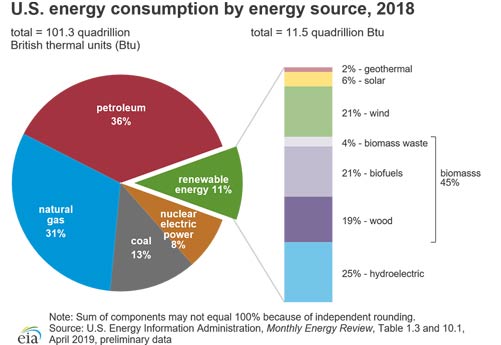
image source: eia.gov and our world in data org
Renewable energy has an essential role in reducing greenhouse gas emissions. Using renewable energy can minimize the use of fossil fuels, which are significant sources of U.S. carbon dioxide emissions.
The consumption of bio-fuels & other non-hydroelectric renewable energy sources in the U.S. more than doubled from 2000 to 2018. Because of state and federal government requirements incentives to use renewable energy.
The U.S. Energy Information Administration projects that – “U.S. renewable energy consumption will remain increasing through 2050.” (U.S. Energy Information Administration, 2019)
Top 10 countries who achieved the highest electricity production from renewable sources
Countries all around the world are driving towards a low-carbon future by embracing Renewable energy sources. Let’s have a look at which countries are leading the charge:
Sweden and its Clean Renewable energy goal:

In 2015, Sweden set the gauntlet with an ambitious goal. They aim to eliminate fossil fuels from electricity generation by 2040 within its borders. They ramped up investment in solar, wind, energy storage, smart grids, and clean transport.
Costa Rica has achieved 95% renewable energy :

Costa Rica has produced 95 percent of its electricity from hydro, geothermal, solar, and wind over the past four years. Costa Rica is aiming to be a carbon-free country by 2021.
Nicaragua has aiming 90% renewables by 2020:

In 2012, Nicaragua invested the 5th highest percentage worldwide of its GDP in developing renewable energy. Next is planning for 90% renewable by 2020. Their majority of electricity coming from wind, solar, and geothermal sources.
Scotland aiming to generate 98% clean renewable electricity by wind power:

The answer to Scotland’s energy requirements is blowing in the wind. In October, wind power generated 98 percent of Scotland’s electricity needs.
Germany is leading the world by adopting renewable energy :

Germany has become world leader in renewable energy. It produced sufficient electricity to power every household in the country for a year, in the first half of 2018. The country has also set an motivated target to get 65% of their electricity from renewables by 2030. For a moderately cloudy country of over 80 million people, Germany is looking forward to a seriously bright future with solar energy! (Climate Council, 2019)
Uruguay is now nearly 100% powered by renewable energy sources:
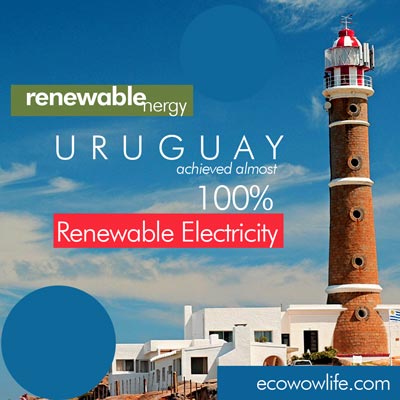
Uruguay is now mostly 100% powered by renewable energy almost after less than ten years of concerted effort. The country advanced heavily in wind and solar, rising from just 40% renewables as recently as 2012. (Climate Council, 2019)
Denmark receives over half of its electricity from wind and solar power :

Denmark produce nearly half of its electricity from wind and solar power, and in 2017, 43% of its electricity was from wind a new world record! That’s the maximum percentage of wind power ever succeeded worldwide. The country targeted to be 100% fossil-fuel-free by 2050. (Climate Council, 2019)
China is generating 35% electricity from Clean renewable sources:

Wondering how the world’s major carbon emitter can also be a leader in renewable energy? It may appear counter-intuitive, but in 2017 China had by far the largest amount of solar PV and wind capacity has been installed of any country – by a long shot. China has also dedicated to generating 35% of its electricity from sources of renewable by 2030 and cleaning up its polluted air.
Morocco aiming to provide half of Morocco’s electricity by 2020 from Renewable:

With ample sun, Morocco took a decision to go big. Bigger than anyone else in the world. With its associated hydro and wind plants, the mega-project is expected to provide half of Morocco’s electricity by 2020.
United States earned a fifth place on the installed solar PV capacity global rankings:

In the US, a new type of solar energy system installed in every two minutes and 30 seconds in 2014. US earned a fifth place on the installed solar PV capacity global rankings. America also has the 2nd highest installed wind energy capacity in the world after China.
Kenya and His clean renewable goals:
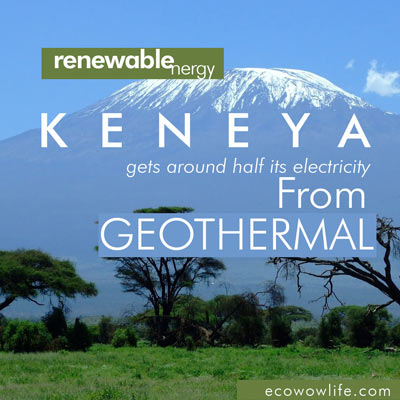
Could you believe it? This country is approaching to geothermal energy to power its future and reduce reliance on costly electricity imports. Kenya receives around half its electricity from geothermal– up from only 13% in 2010.
Not only those countries adopt this alternative energy but also a lot of leading companies such as Google, Apple, Intel, Facebook, IBM, Tesla, Amazon so on are starting to invest and adopt renewable energy.
List of big giant Companies with renewable energy goals :
Apple, Google, Intel, Facebook, Amazon, Target lot of big giant companies already start to invest a lot of money in the renewable energy sector. They are running a lot of renewable projects, and below, we discuss some of them.
Intel with their renewable energy goal:
Intel’s promise to renewable energy is carried into sharp focus by its Global Climate Change Policy Statement:
“Climate change is happening, and human actions have played a strong contributing role – that is the consensus among climate scientists.
The main questions today concern what footsteps can be taken to mitigate the warming trend and help communities and regions adapt to the present day and anticipated impacts of the warming that already is occurring.
Intel Corporation agrees that global climate change is a serious environmental, economic, and social challenge that warrants an equally severe response by governments and the private sector.” (The climate reality project, 2016)
Apple with its renewable energy goal:
Like Intel, Apple also has an inclusive climate change plan, where it identifies its carbon footprint and what it is attempting to mitigate it. The tech giant has considered its in-the-works newly build main campus in Cupertino, California. It’s powered by 100 percent renewable energy. Which will primarily be produced at what will become one of the largest onsite corporate solar installations in the world? (The climate reality project, 2016)
Facebook contributes hugely to renewable energy:
Its goal is to, “We’re taking action by setting a science-based target to reduce our greenhouse gas emissions by 75% in 2020, from 2017 levels. Our operations achieved 75% renewable energy and a 44% reduction in GHG emissions in 2018. We’re proud to work on sustainability solutions that bring the world closer together”. (Nastu, 2018)
Target also invest in Solar Energy :
Target took the top as the leading US corporate solar installer in 2016 with 147.5 megawatts (MW) of installed solar capacity. (Solar energy industries association, 2016)
The 7 Barriers towards Renewable Energy Technologies
After analyzing the data, we found a lot of obstacles and barriers to renewable energy. Here we sort out seven main obstacles for deploying this renewable energy.
Around the world, renewables are in crisis. They are making: electricity more expensive
- Subsidies are expiring
- Local communities and wildlife conservationists are obstructing projects.
Let’s have a look at 7 major barriers towards renewable energy:
- People are still using & dependent upon coal:
Coal contributes one-third of the global energy supply. It is making up about 40% of electricity generation. Also playing a very significant industrial role. Its ready availability mode is making it hard to replace coal as a source of energy. With the advent of technology, the burning of coal has been made cleaner and efficient than it used to be. The kind of infrastructural changes required for switching to renewable sources is costly. And it also needs time.
- Political and regulatory barriers:
Lack of policies and regulations are a barrier to renewable source adoption. Its market needs clear policies. Legal procedures also required to increase the interest of investors. But, in some countries like India, there are no complete renewable energy policy declarations. Because most renewable technologies in the country remain in the advancement & immature stage.
- Technical barriers:
Technical barriers to renewable energy progress include inadequate technology. Also, the lack of infrastructure necessary to support the technologies. A study conducted by Saskatchewan, Canada. It claimed, technology identified as one of the main barriers to invest in wind-generated electricity.
- Renewable energy technologies are not available in many places. They are not sustained well in some areas like in the developing countries, especially Sub-Saharan Africa. The reasons are:
-There is a lack of trained personnel
-Maintenance and operational facilities for renewable energy structures
-Those regions have low education levels; people are unwilling to import the technologies for fear of failure.
- Currently, in some countries, renewable technologies are costly compared to the use of non-renewable technologies.
- Also, lack of physical facilities for transmission and distribution networks. Also, the lack of equipment and services necessary for power companies are some obstacles. These are significant infrastructural challenges for renewable energy development in most developing countries.
- Social-cultural barriers
- Households’ shows unwillingness to accept renewable energy for fear of unreliability.
- General public disinterest
- Public’s disengagement in wind energy development identified in Saskatchewan, Canada.
- Lack of technical knowledge and awareness of renewable energy technologies amongst rural communities.
- Financial and economic barriers:
The crucial factors that determine the rate of renewable energy technologies adoption are:
- Initial high capital cost
- transaction costs
- economic status
- availability of incentives
- subsidies
Most producers prefer to keep initial investment costs low while maximizing profits. High prices of investment remain a significant barrier for its implementation.
- Market-related barriers:
Initial investments for renewable energy systems are generally high. Market prices remain high and unaffordable to many potential customers. Specific problems are generally common in developing countries. Its’ total production also costs relatively high compared to fossil fuels. So the market prices for renewable energy remain relatively high.
- Geographical and ecological barriers:
The underlying problems with renewables like solar and wind are given below:
- They are too unreliable and energy-dilute.
- Wind farms and solar require between 400 and 750 times more land than nuclear and natural gas plants. Renewable energy, like solar panels & windmills, needs massive space for its installation. Usually, for this purpose, the big area of land is deforested, and species are being cleared.
- In this way, many birds, insects, and other species are endangered. They are creating problems with the local community too. Moreover, renewable sources causing costly electricity retail prices.
- In Nebraska, many birds, insects, and other species are being endangered. They are creating problems with the local community too. (Shellenberger, 2019)
10 Facts of Renewable Energy :
There are several interesting facts about renewable energy, and here we list ten facts of renewable power:
- According to WWF(World Wide Fund for Nature), it is possible to generate electricity enough to meet the global demand from renewable resources by 2050
- Google, Apple and Facebook heading towards powering the web through green energy
- Fossil fuels receive subsidies 20 times more than of renewable
- Solar panels cover the pyramids of Giza. (Alux.com, 2018)
- Comparing the continents, Asia generated the highest (200000MW) amount of electricity by solar energy in 2016
- Michael R. Bloomberg, the last mayor of New York City, said he would donate $500 million to a new promotion to close every coal-fired power plant in the United States and halt the growth of natural gas. (Friedman, 2019)
- Mongolia is investing $85 million in wind turbines. (Downing, 2012)
- Singapore is launching a blockchain market for renewable energy, as it’s considered as modern energy. (Alux.com, 2018)
- Tidal power could be used in the future where a device is installed underwater at the ocean floor to create a hydroelectric turbine. It might give power to roughly 2,500 homes of a residential area. (Almaghraby, 2019)
- ‘Renewable energy is too expensive’ is a myth
What Does 100% Renewable Energy mean? Here’s what it would take for the US to run on 100% renewable energy?
It’s being aimed to transition to 100% clean, safe, and renewable energy in less than two decades. It means quickly ending the use of fossil fuels, natural gas, and nuclear reactors. The global major energy generation in the 100% renewable energy structure will consist of the following mix of energy sources:
- Solar energy (69%)
- Wind power (18%)
- Hydro (3%)
- Bio-energy (6%) and
- Geothermal energy (2%)
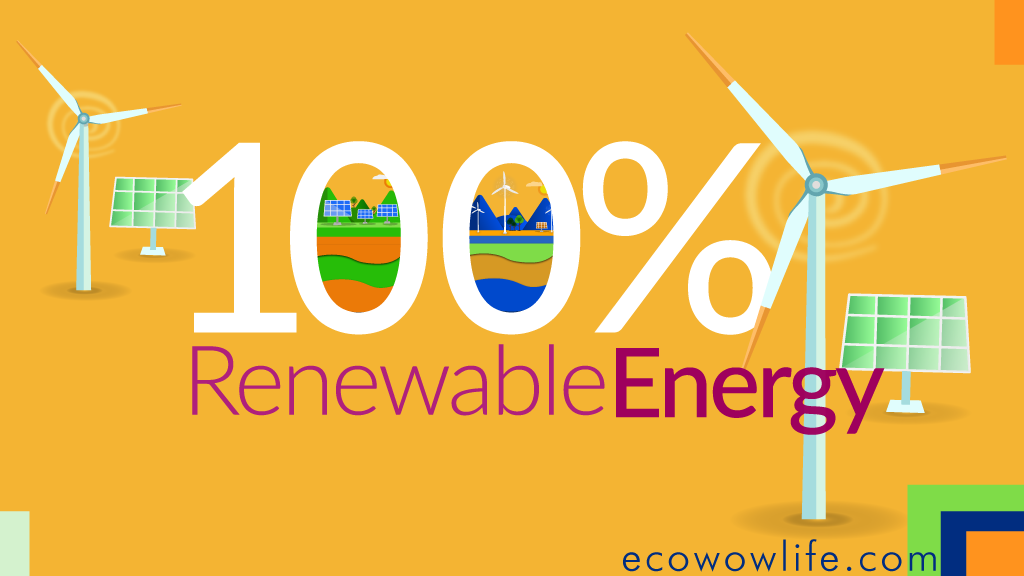
The endeavor is to use 100% renewable energy for electricity, heating/cooling, and transport. It’s motivated by global warming, pollution, and other environmental issues. Economic and energy security concerns also drive them.
The US to run on 100% renewable energy :
At the University of California and Stanford University at Berkeley found from an analysis studied by researchers in 2015 that –
“100% wind and solar power that in conjunction with energy efficiency, energy storage and other advances to complement renewable energy can provide electricity to the continental U.S. more reliably than the current system by 2050, and at lesser projected costs.” (Smith & Walker, 2019)
The analysis also showed why 100 percent of renewables is a feasible and affordable option in the US and concluded:
- There’s more than enough wind, solar, and hydro potential – 30 times more than business-as-usual forecasts for energy demand in 2050.
- The technology already exists to account for the variability of wind and solar generation. Therefore the lights will halt on even when the weather doesn’t cooperate.
- We do not need to change the design of the electric grid radically to accommodate 100% renewables. The shift is well underway and accelerating.
- Costs won’t be overwhelming. A grid-based on 100% renewables can compete in price with fossil fuel systems. The renewable cost is not overpowering even before factoring the tremendous costs of pollution, global warming, and water usage. (Smith & Walker, 2019)
Several counties and regions are at or close to 100% renewable energy already, including Denmark, Norway, and Germany. Canada is at 62% renewables, where Brazil is at 76% (Smith & Walker, 2019).
Germany has passeed a emblematic milestone in its energy transition recently. They briefly cover around 100% of electricity use with renewable sources for the first time on 1 January. (Amelang, 2018)
Final thought about Clean Renewable energy :
Now we can see a flipping coin which has two options: One is clean renewable energy & another is non-renewable.
And some studies showed it is effective & efficient to use 100% renewable energy. Other studies also showed to use of Nuclear energy. It could be more cost-effective, efficient & environmental friendly if it’s used with proper storage & caution.
More research on renewable technologies should be done before final installation worldwide so that it doesn’t cost on any species, Environment & its world. Moreover, the renewable technologies should be advanced on that form so that it’s getting cheaper and easily accessible.
Renewable energy sources are the modern energy roots would be the pioneer to future green civilization. Proper policy-making, an incredibly supportive regulatory environment, and a solid partnership between the public & private sector, will create pathways to implement a sustainable future with renewable energies.
[…] heat and power 31.6-71.9 million homes in a year. The fashion industry should focus on utilizing clean renewable energy such as solar energy, wind energy, and so […]